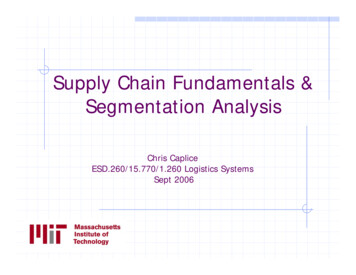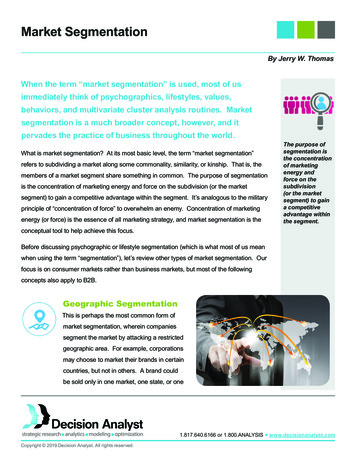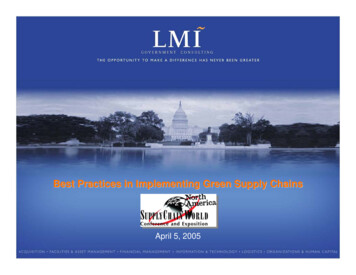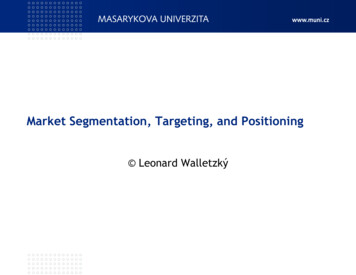
Transcription
Supply Chain Fundamentals &Segmentation AnalysisChris CapliceESD.260/15.770/1.260 Logistics SystemsSept 2006
Supply Chain Management Definitions“Supply Chain Management deals with the management of materials,information, and financial flows in a network consisting of suppliers,manufacturers, distributors, and customers.“Prof. Hau Lee - Stanford Supply Chain Forum“Call it distribution or logistics or supply chain management. Bywhatever name it is the sinuous, gritty, and cumbersome process bywhich companies move material, parts, and products to customers.”Fortune (1994)MIT Center for Transportation & Logistics – ESD.2602 Chris Caplice, MIT
So, what interesting Supply Chain / Logisticsquestions should I ask?Images of athletic shoe and potato chip bagremoved due to copyright restrictions.MIT Center for Transportation & Logistics – ESD.2603 Chris Caplice, MIT
Supply-Chain Operations Reference (SCOR) ModelPlanP1 Plan Supply ChainSourceMakeS2 Source MTO ProductsP5 Plan ReturnsDeliverM1 Make-to-StockS1 Source Stocked ProductsS3 Source ETO ProductsP4 Plan DeliverP3 Plan MakeD1 Deliver Stocked ProductsM2 Make-to-OrderM3 Engineer-to-OrderD2 Deliver MTO ProductsD3 Deliver ETO ProductsCustomersSuppliersP2 Plan SourceReturnDeliverReturnSourceEnableSource: Supply Chain CouncilMIT Center for Transportation & Logistics – ESD.2604 Chris Caplice, MIT
Traditional Functional ViewPurchasing / Procurement Order ProcessingWhat to buy from whoCorporate vs Group Inventory Control TransportationHow much to stock whereTrigger pointsReplenishment plan Warehousing GeographicProduct Line SpecificPlanning GroupHow to move productPackaging, containerizationStorage layoutMIT Center for Transportation & Logistics – ESD.260Inbound versus OutboundDomestic versus InternationalModal control (Rail, TL, LTL,Parcel, Air, etc.)Customer ServiceStorage, Mixing, Break bulkPick Pack and ShipWhat to stock where in WHMaterials Handling Receiving, Entry & StatusOrder Management 5Facility LocationNetwork DesignDemand Planning Chris Caplice, MIT
Supply Chain as a SystemTake an Engineering Systems Perspective What is a variable and what is a constraint?Continuous expansion of decision variablesIncreases potential for improvement but increases bothcomplexity and coordination requirementsCustomer SvcTransportationOrder ProcessingMaterial HandlingInventory MgmtWarehousingPurchasingObjective: Deliver at lowest transport costVariable: Select carrier to tender each load toConstraints:Ship everything each dayMust deliver within specified windowsMIT Center for Transportation & Logistics – ESD.2606 Chris Caplice, MIT
Supply Chain as a SystemTake an Engineering Systems Perspective What is a variable and what is a constraint?Continuous expansion of decision variablesIncreases potential for improvement but increases bothcomplexity and coordination requirementsObjective: Deliver at lowest total costVariables: Select carrier to tender each load to Select time windows to deliver Select when to ship what from whereConstraints:Deliver within negotiated time frameMIT Center for Transportation & Logistics – ESD.260Customer SvcTransportationOrder ProcessingMaterial HandlingInventory MgmtWarehousingPurchasingObjective: Deliver at lowest transport costVariables: Select carrier to tender each load to Select time windows to deliverConstraints:Ship everything each day7 Chris Caplice, MIT
Supply Chain as a SystemTake an Engineering Systems Perspective What is a variable and what is a constraint?Continuous expansion of decision variablesIncreases potential for improvement but increases bothcomplexity and coordination requirements8Customer SvcTransportationOrder ProcessingMaterial HandlingInventory MgmtWarehousingPurchasingManufacturingProduct DesignMIT Center for Transportation & Logistics – ESD.260Objective: Design, build, and deliver at lowesttotal costVariables: Select carrier to tender each load to Select time windows to deliver Select when to ship what from where Determine where to stock which formof productConstraints:Deliver within negotiated time frame Chris Caplice, MIT
Supply Chain as a SystemTake an Engineering Systems Perspective What is a variable and what is a constraint?Continuous expansion of decision variablesIncreases potential for improvement but increases bothcomplexity and coordination requirements9RetailerMIT Center for Transportation & Logistics – ESD.260Customer SvcTransportationOrder ProcessingMaterial HandlingInventory MgmtWarehousingPurchasingManufacturingProduct DesignSupplierWhy is this so hard to do?Objective: Maximize on-shelf availabilityVariables: Select carrier to tender each loadto Select time windows to deliver Select when to ship what fromwhere Determine where to stock whichform of product Select contract relationships Select who should controlreplenishment Which channel member shouldperform which functionConstraints:Total delivered cost to shelf Chris Caplice, MIT
How will the Supply Chains differ?Images of athletic shoe and potato chip bagremoved due to copyright restrictions.MIT Center for Transportation & Logistics – ESD.26010 Chris Caplice, MIT
Supply Chain SegmentationThere is no such thing as a one-size-fits-all supply chainMost firms/business units operate multiple supply chainsDifferent supply chains require different methods for: ForecastingDemand PlanningInventory PlanningTransportationPurchasing / ProcurementInventory ControlWarehousingMaterials HandlingOrder ManagementTransportationCustomer ServiceWhy segment?MIT Center for Transportation & Logistics – ESD.26011 Chris Caplice, MIT
Segmentation & Portfolio ManagementHow many segments? (Rules of thumb) Homogenous- items within the segment are all similarHeterogeneous- items between segments should bevery differentCritical Mass - the segment should have enoughnumber to make it worthwhilePragmatic - the dimensions should be useful andcommunicableSegmentation in Supply Chain Management Customer, Product, SupplierMore recently – combinations of theseMIT Center for Transportation & Logistics – ESD.26012Source: Prashant Yadav 2005 Chris Caplice, MIT
Supply Chain SegmentationHow can I segment my customers/vendors? Lead time requirementsService level requirementsPurchase HistoryOrder Size and VolumeGeographicalDemographicSales TrendsChannel SegmentationHow can I segment my products? Physical characteristicsDemand characteristicsSupplier characteristicsMIT Center for Transportation & Logistics – ESD.26013Source: Prashant Yadav 2005 Chris Caplice, MIT
Product SegmentationExample: Grocery Store: 8000 SKUs (only Dry Goods)Total SKUs sold within 1 year 1.156 M items (SKUs) sold Number of units sold per SKU Mean 144Median 72Mode 0Std Dev 355Biggest Sellers?Biggest Sales Day?1.2.3.4.5.6.7.8.9.10.1.2.3.Top 10 Sellers!EVAP MILK 12 OZENFAMIL IRON POWDERENFAMIL W/IRON 13OZBATH TISS 1PLYSCOT WHT BTH TTP SPRING WTR 1 GALLNSH GR SUGAR5LB FBLTKR MAC N CHEESEPAST KTCH RDY TOMGEISHA SLD WHT TUNATop Sales Days!24 November 20041 February 200410 April 2004How are products distributed in terms of salesvolume?Uniform? Normal? Other?MIT Center for Transportation & Logistics – ESD.26014 Chris Caplice, MIT
100%100%90%90%Percent of Items SoldPercent of Items Sold80%80%70%70%60%60%0.37840.3784yy 1.1245x1.1245x2RR2 10%10%20%20%30%30%40%50%60%40%50%60%Percent of ProductsPercent of Products70%70%80%80%90%90%100%100%This is an example of the Power Law, y axkWhy is this important?Is this distribution unique?MIT Center for Transportation & Logistics – ESD.26015 Chris Caplice, MIT
Power Law (y axk)Exceptionally common in physical and social systems Severity of hurricanes and earthquakesFailures of parts due to wear and tearIncome within a population (Pareto’s Law)Distribution of volume on traffic lanesQuestions from studentsVisits to websites (Nielsen’s Law) & blogsFrequency of words in any language (Zipf’s Law)Frequency of digits within tables (Benford’s Law)Frequency of authors citations in literature (Lotka’s Law)Animals’ metabolic rates wrt to mass (Kleiber’s Law)Profitability of customers & productsThe important few versus the trivial manyFundamental InsightDistribution of many phenomena across apopulation follow a Power Law relationshipMIT Center for Transportation & Logistics – ESD.26016 Chris Caplice, MIT
Segmentation: ABC AnalysisPart D378HJQ223LK990RT58JH42340P378438JQ256TT77UJS2 ,677Identify the SKUs thatmanagement should spend timeonPrioritize SKUs by their value tofirmCreate logical groupingsAdjust as neededAnnual Value 585.00 122.55 31.50 298.76 2,723.40 1,342.00 341.00 1,037.52 179.20 8,346.66 186.00 52.36 14.00 346.21 5,197.50 410.52 125.80 531.30 63.96 48.60 21,983.84MIT Center for Transportation & Logistics – ESD.260Example: 17Sample of 20 SKUsTotal of 4,677 unitsTotal 22k Chris Caplice, MIT
Segmentation: ABC AnalysisPart 001978SD345O337843K6256TT778HJQ27UJS28845023LK ,677Annual Value 8,347 5,198 2,723 1,342 1,038 585 531 411 346 341 299 186 179 126 123 64 52 49 32 14 21,984MIT Center for Transportation & Logistics – ESD.260 18Cum Pct AnnValue ,890100%21,938100%21,970100%21,984100%A Items:80% of Value20% of SKUsB Items:15% of Value30% of SKUsC Items:5% of Value50% of SKUs Chris Caplice, MIT
Segmentation: ABC 15%100%90%80%70%60%50%40%30%20%10%0%5%Percent of Annual ValueDistribution By ValuePercent of SKUsMIT Center for Transportation & Logistics – ESD.26019 Chris Caplice, MIT
Segmentation: ABC AnalysisSo, what is different between the classes? A Items Very few high impact items are included Require the most managerial attention and review Expect many exceptions to be made B Items Many moderate impact items (sometimes most) Automated control w/ management by exception Rules can be used for A (but usually too many exceptions) C Items Many if not most of the items that make up minor impactControl systems should be as simple as possibleReduce wasted management time and attentionGroup into common regions, suppliers, end usersBut – these are arbitrary classificationsMIT Center for Transportation & Logistics – ESD.26020 Chris Caplice, MIT
Segmentation: ABC AnalysisDemand variabilityHLCBAEconomic valueVolatile: Sophisticated techniques; frequent reviewsStable: Less sophisticated techniques; less frequent reviewsUnimportant: Unsophisticated techniques; infrequent reviewsMIT Center for Transportation & Logistics – ESD.26021Source: Prashant Yadav 2005 Chris Caplice, MIT
Segmentation: ABC AnalysisSo, what should we do with C items? Traditional Approach Handle as simply as possible to minimize cost Eliminate if possible to be able to focus on A & B Other thoughts?Sales Volume By SKU20%Top 1% of products 36% salesTop 5% of products 67% sales18%Percent of Sales16%14%12%Bottom 95% account for 33% sales10%8%6%4%2%0%050100150200250300SKU (300 total)MIT Center for Transportation & Logistics – ESD.26022 Chris Caplice, MIT
Segmentation: The Long TailExamples: Books Amazon.com stocks over 3 M titles Most brick & mortar stores stock between 40-100k 25% - 40% of Amazon.com sales are books not stocked in stores Music / CDs Rhapsody offers 1.5 M tracks Wal*Mart offers 4,500 CDs (or about 55,000 tracks) 40% of Rhapsody sales come from titles not stocked in stores Movies / DVDs Netflix offers over 55,000 titlesBlockbuster offers 3,000 titles21% of Netflix sales come from titles not stocked in storesWhile 80% of sales for a DVD occur within 2 months of release, marginsactually increase for older releases!When does it make sense to expand the tail?Sources: Brynjolfsson, Hu, and Smith, (2006) “From Niches to Riches: Anatomy of the Long Tail,” MIT Sloan Management Review Anderson, (2006) The Long Tail, Hyperion Press.MIT Center for Transportation & Logistics – ESD.26023 Chris Caplice, MIT
Bottom Line(s)Supply Chain Management is . . . An integrated activity, X-functions, X-divisions, X-companies, etc. Coordination of conflicting goals, metrics, etc. Involves multiple flows, Physical (raw materials, wip, finished goods) Information (orders, status, contracts) Financial (payment, credits, etc.) Requires trade-offs, Across different entities Across metrics: Cost, Service, Time, Risk, Flexibility, etc. Deals with uncertainty, Uncertainty in supply, process, and demand Consider both flexibility and robustness Portfolio of approaches are usually needed. There is no one size fits all anything in SCM Knowing when to apply which approach is critical to successMIT Center for Transportation & Logistics – ESD.26024 Chris Caplice, MIT
Core Concepts of ESD.260Model Based Approach Use fundamental models to gain insightsAnalytical, not necessarily OR, approachExtensive use of real examples – but not case studiesTotal System Perspective Avoid the silo effect of traditional logisticsCapture and integrate across different players in SCService can be includedPortfolio of Solutions Rarely is a single solution sufficient or practicalA set of solutions is usually more applicableThe context mattersManagement of Uncertainty Risk can be measured, monitored, and managedImpacts sourcing, contracting, pricing, incentives, etc.MIT Center for Transportation & Logistics – ESD.26025 Chris Caplice, MIT
Fit with Other MIT SCMish ClassesStrategic – How does SCM fit into larger company issues?Classes: ESD.261/15.771 – Case Studies in Logistics and SCM (Byrnes)ESD.265/2.965 International Logistics (Marcus & Weiss)15.769 Operations Strategy (Rosenfield, Novak)ESD.267/15.762 – Supply Chain Planning (Graves & Simchi-Levi)ESD.268/15.763 – Mfg System & SC Design (Graves & Simchi-Levi)Analytical – How to answer specific, practical SCM questions using analytical tools?Classes: ESD.260/15.770 – Logistics Systems (Caplice & Sheffi)Methodological – How and why do the underlying methodologies and approaches work?Classes: ESD.273 – Logistics and SCM (Simchi-Levi)15.764 – Theory of Operations Management (Gallien)1.203/ESD216 – Log & Transp Planning Methods (Larson, Odoni, & Barnett)15.081, .082, .083, .084, .085 – ORC track for optimization & probabilityMIT Center for Transportation & Logistics – ESD.26026 Chris Caplice, MIT
Questions?Comments?Suggestions?
Supply Chain Management Definitions "Supply Chain Management deals with the management of materials, information, and financial flows in a network consisting of suppliers, manufacturers, distributors, and customers." Prof. Hau Lee - Stanford Supply Chain Forum "Call it distribution or logistics or supply chain management. By










